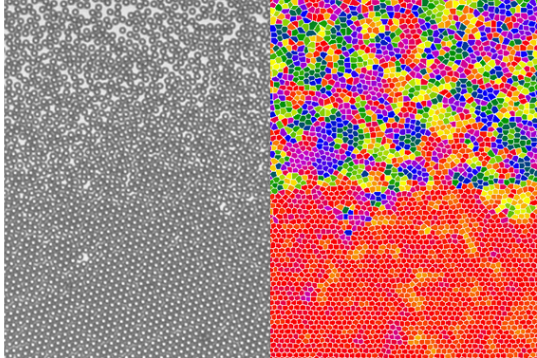By Dr Alice Thorneywork
Be it ice in a drink, chocolate left in the sun, or the wax of a lit candle, melting – the phase transition in which a substance turns from a solid to a liquid – is a scientific phenomenon that we experience every day. While on a macroscopic level we know what melting looks like, understanding how this process arises from the collective behaviour of the individual particles that make up these materials is an extremely challenging problem.
Especially mysterious is the case of melting in two-dimensions, which has long been thought to be a more complex process than that which occurs in three-dimensions. Here, it has been proposed theoretically that there exists an additional, partially disordered phase, the ‘hexatic’, as a “topological” halfway point in the melting process between the solid and the liquid. This idea forms the centre-point of KTHNY theory, based upon Kosterlitz and Thouless’s Nobel Prize-winning research.
Despite this work, fully understanding the 2D melting transition has been a surprisingly difficult problem for the simplest interacting system – hard spheres. These are systems of particles with an interaction rather like that of snooker balls – they can’t overlap, but don’t ‘feel’ each other at larger distances. Substantial debate as to the nature of the 2D melting transition in these systems dates back to the 1950s, when the problem was first studied in the earliest computer simulations. Our work aimed to settle this debate by determining experimentally how these hard sphere systems melt in two dimensions.
As with many natural phenomena, obtaining this fundamental understanding in a molecular system is very difficult, as here things occur very quickly, at very small length scales and often with many other competing processes. As such, experimental model systems that are simpler, but display similar physics can provide powerful insight. Colloidal suspensions – systems comprised of microscale particles dispersed in a solvent – represent a rich source of these model systems, and are an excellent experimental source of hard sphere systems. Importantly, the Brownian motion of colloidal particles is analogous to the thermal motion of atomic systems, but their characteristic size allows for detailed study under the microscope. This means we can directly see how the individual particles move and form structures, with the packing fraction (density of particles) acting as an inverse temperature and thus controlling the phase behaviour.
To probe the melting transition, we studied layers of colloidal particles tilted at very small angles to induce a gradient in the concentration, allowing us to identify and characterise the liquid, hexatic and crystal phase in a single experiment. This revealed two key stages of the transition, with melting occurring via a first-order liquid-hexatic transition followed by a continuous hexatic-crystal transition. Furthermore, it was possible to directly visualise the fluctuating interface between the liquid and hexatic phases. As such, we provided the first definitive experimental evidence for how this simplest of two-dimensional systems melts, resolving a long-standing problem from condensed matter physics.
While we think of the world around us as existing in three-dimensions, we frequently encounter systems with two-dimensional characteristics. For example, surfaces and interfaces have substantial 2D character and in recent years single layer materials such as graphene have developed widespread significance. The explosion of interest in the latter arises from its novel, sometimes superlative, properties, which can result from its low dimensionality. Our work elucidating fundamental aspects of how phase transitions might occur in these exotic, two-dimensional systems helps us to better understand these materials, and supports improvements to their use in modern technologies.
Dr Alice Thorneywork is an Oppenheimer research fellow at the Cavendish Laboratory, University of Cambridge and Raymond and Beverley Sackler Research By-Fellow at Churchill College. She completed her DPhil in Physical and Theoretical Chemistry at University of Oxford in 2015 and was awarded the 2019 RSC Statistical Mechanics and Thermodynamics group Young Scientist award for her experimental verification of the melting scenario in two-dimensional colloidal hard spheres.
Featured image – a colloidal mono-layer showing the transition from liquid (top, multi-colour) to hexatic and crystal (bottom, single-colour).





